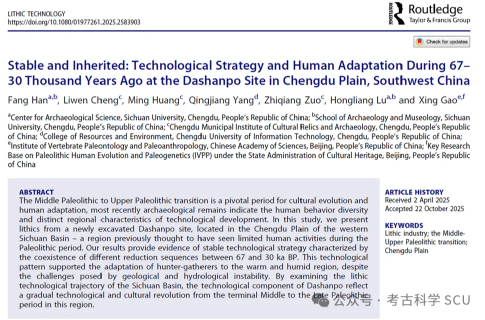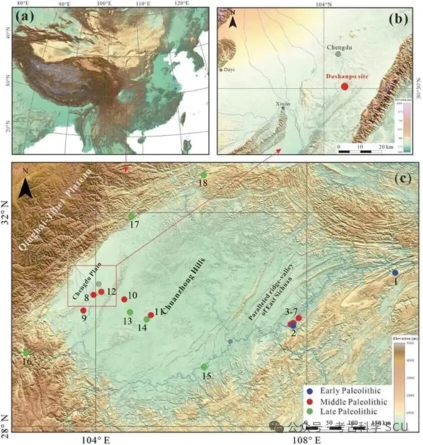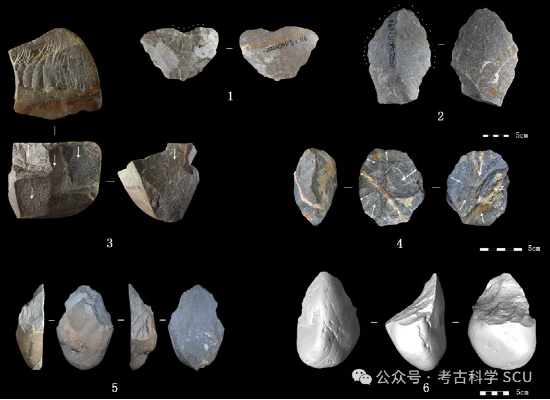Lithic Technol. | Technological Strategies and Environmental Adaptation of Ancient Humans in the Chengdu Plain During the Transition from the Middle to Late Paleolithic
The transition from the Middle to the Late Paleolithic was a critical period for human technological evolution and environmental adaptation. Increasing archaeological discoveries indicate that ancient human behavioral diversity and lithic technological development during this period exhibited distinct regional characteristics. The Chengdu Plain, located in the western Sichuan Basin of Southwest China, was previously thought to lack long-term human activity during the Paleolithic Age due to the influence of the Longmen Mountain tectonic belt and changes in river systems. Recently, the School of Archaeology and Museology at Sichuan University, in collaboration with the Chengdu Municipal Institute of Cultural Relics and Archaeology and the Institute of Vertebrate Paleontology and Paleoanthropology (IVPP) of the Chinese Academy of Sciences, published research findings on the Dashanpo site in *Lithic Technology*. The article is titled "Stable and Inherited: Technological Strategy and Human Adaptation During 67–30 Thousand Years Ago at the Dashanpo Site in Chengdu Plain, Southwest China." Associate Research Fellow Han Fang from the Center for Archaeological Sciences, Sichuan University, is the first author, and Associate Research Fellow Zuo Zhiqiang from the Chengdu Municipal Institute of Cultural Relics and Archaeology is the corresponding author. Co-authors include Associate Research Fellows Cheng Liwen and Huang Ming from the Chengdu Municipal Institute of Cultural Relics and Archaeology, Associate Professor Yang Qingjiang from Chengdu University of Information Technology, Professor Lv Hongliang from the Center for Archaeological Sciences, Sichuan University, and Researcher Gao Xing from the IVPP, Chinese Academy of Sciences. This study reveals the lithic technological landscape of ancient humans in this region from 67,000 to 30,000 years ago, filling a gap in the Paleolithic archaeology of the Chengdu Plain. It provides important empirical evidence for understanding the regional characteristics of the lithic industry in southern China, technological evolution, and adaptive strategies of ancient humans to unstable geological and hydrological environments.

The Dashanpo site is located in the terrace-hill transition zone between Longquan Mountain and the Chengdu Plain. In 2023, the Chengdu Municipal Institute of Cultural Relics and Archaeology and the School of Archaeology and Museology at Sichuan University excavated the site, recovering a total of 1,659 stone artifacts. The distribution characteristics, occurrence state, and degree of weathering and abrasion of the artifacts indicate that the site was not subjected to significant hydraulic transport or disturbance, representing a quasi-primary burial context. Optically Stimulated Luminescence (OSL) dating results show that the cultural deposits of the site date to between 67,000 and 30,000 years ago.

Fig. 1 Geographic location of the Dashanpo site
(a. Topography of the Sichuan Basin; b. Location of the Dashanpo site; c. Paleolithic archaeological sites in the Sichuan region)
Statistical and utilization analysis of lithic raw materials shows that the ancient humans at the Dashanpo site adopted a strategy of "local sourcing." The raw materials for the stone artifacts were all derived from the gravel layers of ancient river channels flowing through the plain. Among them, hard and compact quartzite dominates absolutely, with small amounts of quartz sandstone, quartz, and sandstone. This concentrated exploitation of high-quality quartzite reflects the ancient humans' profound understanding and selective development of the physical properties of local rocks. Analysis of lithic technology reveals diverse core reduction strategies employed by the inhabitants of Dashanpo. The lithic industry of the site belongs to a simple core-flake technology system, dominated by direct hammer percussion, supplemented by a certain proportion of bipolar and anvil techniques. This flexible technological combination targeted at gravel raw materials reflects the tradition of the cobble tool industry in southern China. The presence of discoidal cores at the site reflects that ancient humans possessed high organizational capabilities for reduction and precise control over core flaking. The tool assemblage is dominated by small scrapers (such as side scrapers and end scrapers) made on flakes, coexisting with picks, heavy-duty scrapers, and choppers. This presents a characteristic dominance of small flake tools supplemented by heavy-duty cobble tools, preserving the traits of the early cobble industry while embodying the evolutionary trend towards the late small flake industry.

Fig. 2 Stone artifacts excavated from the Dashanpo site
In terms of geological structure, the Chengdu Plain is located in a zone of intense uplift on the eastern margin of the Qinghai-Tibet Plateau. During the Pleistocene, river systems oscillated frequently, and tectonic activity was active. The Dashanpo site is located in the platform and gentle hill zone at the edge of the plain; this choice of micro-landform provided a natural refuge for ancient humans, protecting them from the intrusion of frequent floods and tectonic activities. Facing an unstable geological and hydrological environment, the ancient humans at the Dashanpo site successfully adapted to this humid, hot, and variable environment by maintaining a stable technological strategy, producing small scrapers adapted to a highly mobile lifestyle and heavy-duty tools for coping with complex subsistence activities.
Looking at the evolution of lithic technology in the Paleolithic of the Sichuan Basin, the cobble tool industry represented by Layer 4 of Yandunbao and the Longgupo site is the typical technological representative of the region in the Early Paleolithic. By the Middle Paleolithic, represented by the Gaojiazhen site and Ranjialukou site in the Three Gorges area of Chongqing, and the recently discovered Wangjiayan Locality 1, Tanguanshan site, Longya site, and Mengxihe site in Chengdu and surrounding areas, lithic technology exhibits characteristics of the coexistence of large cobble tools and a small number of Acheulean technological elements, while small flake tools began to occupy a dominant position. Late Paleolithic sites such as the Liyuqiao site, Fulin site, and Ziyang Man Locality B only show a small flake tool technology system. Research on the lithic technology of the Dashanpo site indicates that it inherited the technical characteristics of large cobble tools from the middle period while being dominated by small flake tools, demonstrating distinct stability and inheritance. This reflects the gradual evolution of ancient human lithic technology and culture based on inherited traditions during the transition from the Middle to the Late Paleolithic in the Sichuan Basin.

Fig. 3 Schematic diagram of the evolution of lithic technology in the Sichuan Basin
